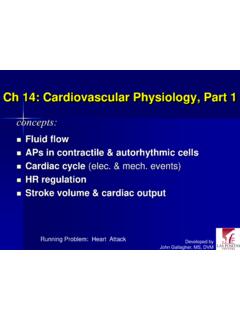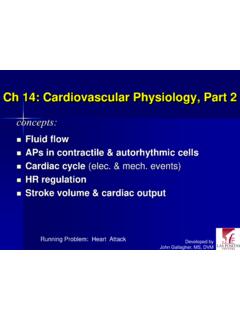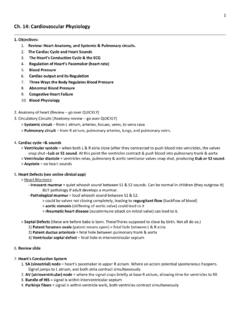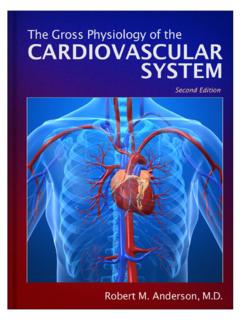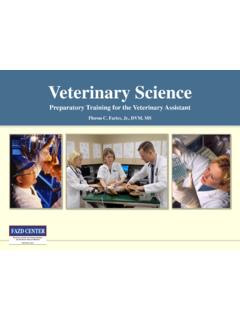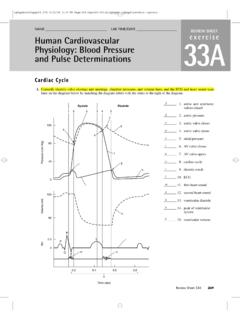Transcription of Introduction to Cardiovascular Physiology
1 Introduction to Cardiovascular PhysiologySam Dudley, MD, PhDOffice: VA room 2A167 Tel: 404-329-4626 Email: of the CV system Purposes Distribute metabolites and O2 Collect wastes and CO2 Thermoregulation Hormone distribution Components Heart the driving force Arteries distribution channels Veins -collection channels Capillaries exchange pointsAnatomy of the vasculatureParallel and series design A given volume of blood passes through a single organ Blood entering an organ has uniform composition Perfusion pressure is the same for each organ Blood flow to each organ can be controlled independentlyRARVLVLAO rgan 1 Organ 2 Organ 3 Relationships among the vascular beds Flow is constant
2 In each segment, so velocity and area are inversely related Pressure loss occurs mainly at the small arterioles, the resistance vessels The veins contain most of the bloodProperties of arteries Elastic arteries Consists of the Aorta and its large branches Fairly distensible because of high elastin content Diastolic elastic recoil provides potential energy for flow when the heart is not contracting Muscular arteries Most of the named arteries Contain increased smooth muscle Large lumen-to-wall ratioProperties of the microcirculation Consists of arterioles, capillaries, and venules Arterioles Reduced lumen-to-wall ratio Controlling point for flow Convert pulsatile to steady flow Capillaries Exchange point between blood and interstitial fluid Mechanisms of exchange include: Diffusion Bulk flow Vesicular transportEquations of exchange Diffusion is described by:where Q is flow, A is area, D is the diffusion coefficient, and dc/dx is the concentration gradient.
3 D incorporates such constants as solubility, temperature, and molecular size. Bulk flow is described by the Starling equation:where Q is the flow of water, P is the hydrostatic pressure difference, is the osmotic pressure difference, and k is the hydrostatic permitivity )( =PkQVeins and lymphatics Veins Thin-walled, smaller amounts of smooth muscle or elastin Slow flow, large cross-sectional area Acts a conduits and reservoirs Venoconstriction raises ventricular filling, cardiac output Lymphatics Drains the interstitium Only route for of returning interstitial proteins Low flow (~2L/day)
4 Cardiac anatomy The myocardial syncytium All atrial cells are coupled, all ventricular cells are coupled,the AV node links the two Connections between cells are known as intercalated disks Electrical activation leads to contraction (EC coupling)Cardiac cellular anatomy Basic units is a sarcomere (Z line to Z line) Think filaments of myosin in the A band Thin filaments of actin in the I band Sarcoplasmic reticulum Holds Ca2+ Forms cisternae Approximation to T tubules (sacrolemmal invaginations) known as a dyadCa2+induced Ca2+releaseRyR2 RyR2Ca2+Ca2+Ca2+ATPCa2+K+Na+Ca2+ATPSARCO LEMMAATPCa2+SARCOPLASMICRETICULUMSARCOME RE Ca2+enters from sacrolemmal Ca2+channels, diffuses to the SR Ca2+release channel (ryanodine receptor), and causes a large Ca2+release.
5 SR Ca2+release raises intracellular Ca2+from 10-7M to 10-5M, enough to cause Ca2+binding to troponin, displacing tropomyosin, causing actin-myosin cross bridge cyclingThe sliding filament hypothesisSliding filaments 2 Length-tension (Frank-Starling Effect) Length of a fiber determines force generation The major determinate of length in the heart is chamber volume The ascending limb results from length-dependent changes in EC coupling The descending limb derives mostly from the number of thick and thin filament cross bridge interactionsPressure-volume loops Determinants of cardiac output (stroke volume x heart rate) Preload or ventricular end diastolic volume Afterload or Aortic pressure Contractility or modulation of active force generation (ESPVR, inotropy) Ventricular compliance (EDPVR, lusitropy) Heart rateESV= end systolic volume.
6 EDV = end-diastolic volume;SV = stroke volumePV loop in heart failureMyocardial work Most myocardial work is potential work Myocardial O2consumption is a function of myocardial wall tension, contractility, and heart rate The law of Laplace:where T is tension, P is pressure, and r is the radius. Larger ventricles have higher wall tension and O2utilization to produce the same pressure as smaller ones =PdVW2Pr/=TThe cardiac cycle Systole Phase 1: atrial contraction Phase 2: Isovolumetric contraction Interval between ventricular systole and semilunar valve opening Phases 3 & 4: rapid and reduced ejection (55-60%) Diastole Phase 5: Isovolumetric relaxation Begins with closure of the semilunar valves Phase 6: Rapid filling Opening of the AV valves Phase 7.
7 DiastasisHemodynamics Flow is a function of a pressure gradient and represents the conversion of potential to kinetic energy Laminar flow is described by Poiseuille s Law: Where P is the pressure gradient, r is the radius, is the viscosity, and l is the length of the 84 =Arterial pressure Rearranging Hook s Law gives:where E is the elastic constant (similar to Young s modulus of elasticity), dP is the pulse pressure, dV is the net systolic arterial uptake ( stroke volume), and V is the mean arterial volume Physiological determinants of ABP include: Heart rate Raises V by decreasing runoff time Stroke volume SV V, mean ABP, dP, dV Increased peripheral vascular resistance Raises V by decreasing runoff Elastic constant generally increases with ageVEdVdP=Venous return Factors affecting venous return Gravity Supine to erect transition shifts ~ 500 mL of blood to the leg veins, decreasing cardiac output and ABP Valves prevent retrograde flow in dependent veins Muscle activity compresses veins to enhance return Respiration Negative intrathoracic pressure enhances venous return Low resistance, low pressure.
8 High distensibility segment Contain 70-80% of circulating blood volumeCV regulation Control of blood volume Neural Baroreceptors and antidiuretic hormone (ADH) Atrial tissue and natriuretic peptides Endocrine ADH release in response to increased osmolarity Renin-angiotensin-aldosterone systemControl of blood volumeControl of arterial pressure Baroreceptors Located in the carotid sinus and aortic arch Receptor potential varies with mean and pulse pressures Efferent pathway is the vagus (X) and glossopharyngeal (IX) nervesControl of arterial pressure (cont) CNS centers Hypothalamus Medulla Autonomic Sympathetic Postganglionic adrenergic fibers vasoconstriction, chronotropy, lusitropy, and inotropy Postganglionic cholinergic fibers skeletal muscle vasodilation Parasympathetic Largely opposes sympathetic actionsLocal control of flowCoupling the heart and vasculatureCardiac function curveVascular function curve)
9 /1(avramsccRPPCO+ =Where Pms, Pra, R, cv, and caare the mean systemic pressure, right atria pressure, total peripheral resistance, arterial and venous capacitance, , Physiology of the Heart, Lippincott Williams & Wilkins, New York, and Levy, Cardiovascular Physiology , 7thEdition, Mosby, St. Louis, 1996.)



